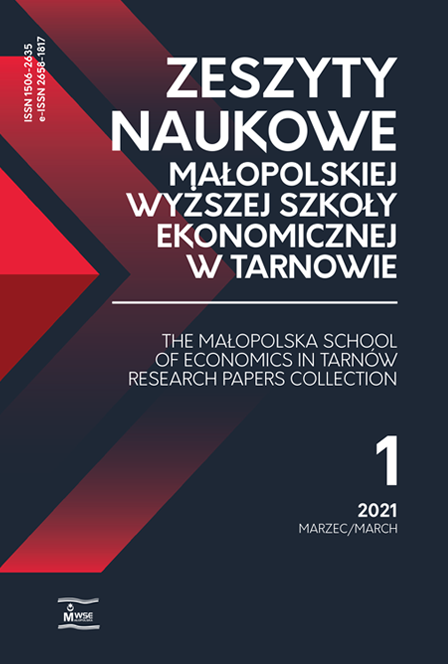Abstract
Nowadays, the measurement of a company’s performance seems to be complex. There are many classical accrual indicators of profitability, like ROA, ROE and EPS. However, the concept of focusing on maximization value for owners has its influence on the main aim of the functioning of business entities. Because of it, and of disadvantages of previously mentioned measures, new ones, referred to value added for shareholders, have been created. Indicators like EVA, MVA and TSR led to the estimation of value created by the company. The aim of this paper is to analyze the added value created by chosen listed companies. The empirical research was focused on comparing added value for shareholders with risk and accrual indicators by using descriptive statistics and correlation. The level of risk among analyzed companies (from IT and video game sector, listed on Warsaw Stock Exchange) was different—quite high for entities, which activity is connected with the video games industry, and lower for IT companies. In general, MVAs and TSRs were characterized by the high volatility of their values. What is more, the higher risk was not related to higher rates of return (measured by TSR). Moreover, there were no significant relationships between accrual indicators and value added measures. What is worth mentioning, the result of the analysis differs from the studies mentioned in the paper. It might be caused by specific sample selection.
References
Biznesradar. (2020). Radar inwestycji [online, accessed: 2020-10-31]. Retrieved from: https://www.biznesradar.pl/.
View in Google Scholar
Comporek, M. (2018). Metodologiczne aspekty naliczania całkowitego zwrotu dla akcjonariuszy spółek giełdowych. Studia Ekonomiczne. Zeszyty Naukowe Uniwersytetu Ekonomicznego w Katowicach, 357, 217–236.
View in Google Scholar
Cucari, M., Mazza, G., Constantini, M., Sancetta, G. (2016). Relationship between CEO pay and total shareholder return: An empirical analysis in the Italian context. Corporate Ownership & Control, 13(4). DOI: 10.22495/cocv13i4c1p4.
View in Google Scholar
Damodaran, A. (2014). Applied corporate finance. Hoboken: John Wiley & Sons. ISBN 9781118808931.
View in Google Scholar
Damodaran, A. (2020). Country risk premium [online, accessed: 2020-02-25]. Retrieved from: http://pages.stern.nyu.edu/~adamodar/.
View in Google Scholar
De Wet, J. H. v. H. (2012). Executive compensation and the EVA and MVA performance of South African listed companies. Southern African Business Review Volume, 16(3), 57–80.
View in Google Scholar
Grabowska, M., Otola, I. (2013). Wartość dodana determinantą konkurencyjności przedsiębiorstwa. In: J. Duraj, A. Sajnóg (eds.). Ekonomiczne i pozaekonomiczne czynniki zarządzania wartością przedsiębiorstwa (pp. 81–96). Łódź: Wydawnictwo Uniwersytetu Łódzkiego. ISBN 9788375258660.
View in Google Scholar
Jóźwiak, M. (2020). Ekonomiczna wartość dodana jako miernik zarządzania wartością przedsiębiorstwa – studium przypadku PKP CARGO S.A. Zeszyty Naukowe Politechniki Częstochowskiej. Zarządzanie, 38, 36–47. DOI: 10.17512/znpcz.2020.2.03.
View in Google Scholar
Kacprzyk, M., Rychter, M., Wolski, R. (2009). Wpływ ekonomicznej wartości dodanej (EVA) na rynkową wartość dodaną. Acta Universitatis Lodziensis. Folia Oeconomica, 226, 199–219.
View in Google Scholar
Kicia, M. (2010). MVA i zysk netto a stopa zwrotu dla spółek giełdowych o najniższej kapitalizacji. Ekonomiczne Problemy Usług, 51, 81–88.
View in Google Scholar
Kiran Kumar, K., Subramanyam, D. A. R. (2017). Shareholders value analysis: EVA & MVA in relations to stock market returns with reference to the Indian cement industry [online: accessed 2020-02-25]. Retrieved from: http://ssrn.com/abstract=2971332. DOI: 10.2139/ssrn.2971332.
View in Google Scholar
Mikołajek-Gocejna, M. (2010). Market-based measures of business value creation and value for shareholders, Financial Internet Quarterly “e-Finance”, 6, 41–56.
View in Google Scholar
Nowicki, D. (2018). Ekonomiczna wartość dodana jako narzędzie dokonań przedsiębiorstwa. Studia Ekonomiczne. Zeszyty Naukowe Uniwersytetu Ekonomicznego w Katowicach, 347, 134–144.
View in Google Scholar
Rajan, S., Ravi, H., Ashfaque, M. (2015). Study the Economic Value Added and its influence on the market price of shares in Indian Stock Market. International Journal of Research in Finance and Marketing, 5(11).
View in Google Scholar
Rappaport, A. (1986). Creating shareholder value: The New standard for business performance. New York: Simer and Schuster Publishing Group. ISBN 9780029257203.
View in Google Scholar
Shah, A., Sengupta, S. (2015). A study on financial performance and valuation metrics: Application of EVA, MVA, CVA and TSR techniques. Twelfth AIMS International Conference on Management, 538–546. ISBN 9788192471389.
View in Google Scholar
Szczukiewicz, P. (2003). Wybór miernika efektywności w dobie globalizacji gospodarki. Zeszyty Naukowe Akademii Ekonomicznej w Krakowie, 594, 47–60.
View in Google Scholar
Wypych, M. (2013). Ekonomiczna wartość dodana w spółkach płacących dywidendy. Zarządzanie i Finanse, 11, 2(2), 569–580.
View in Google Scholar

This work is licensed under a Creative Commons Attribution-NonCommercial-NoDerivatives 4.0 International License.

